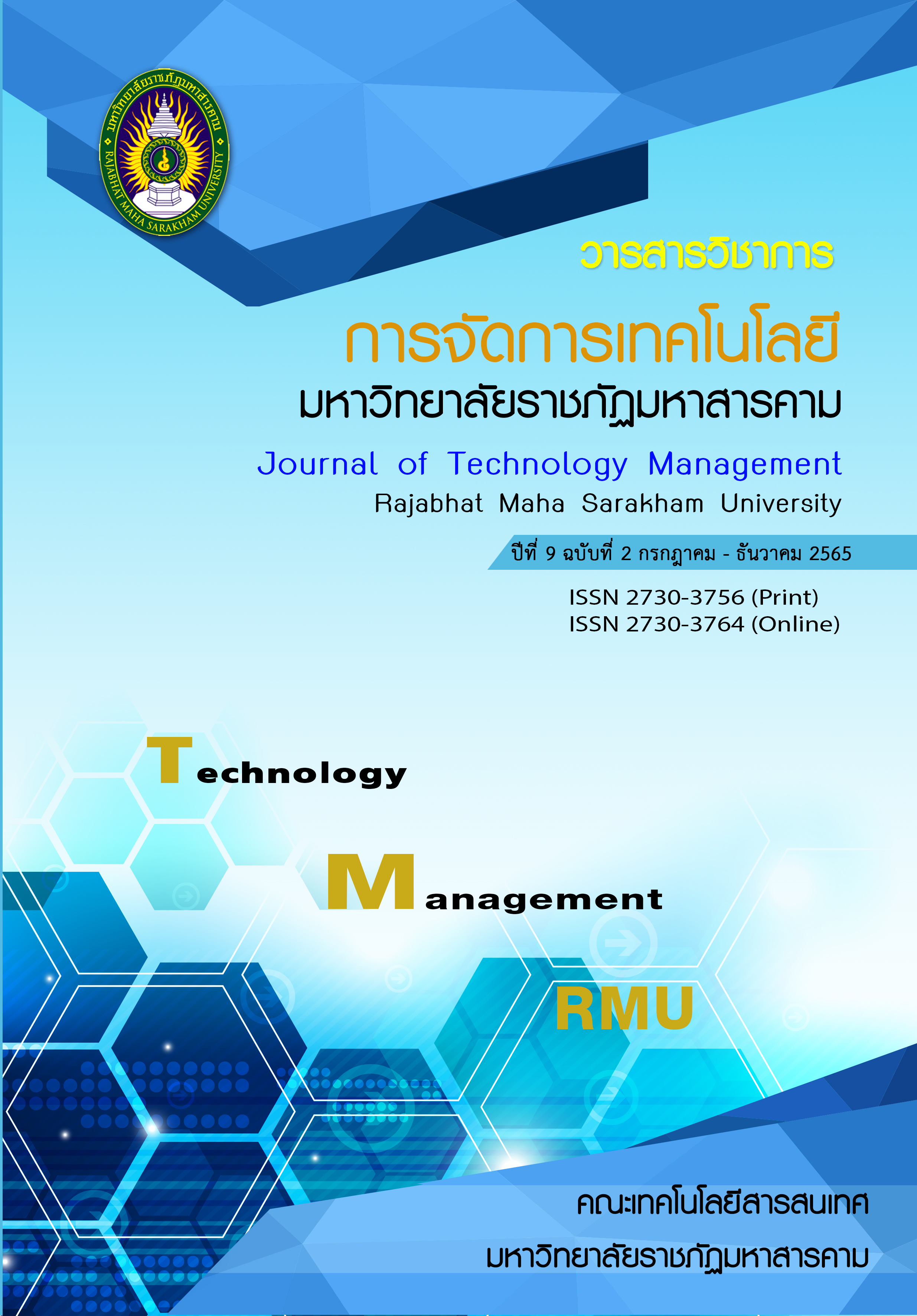Optimization Classification of Covid-19 effect on Liver Cancer
Main Article Content
Abstract
This research aims to 1) identify COVID-19 impact data and 2) enhance data classification by learning to integrate COVID-19 impact data. The method of data classification with algorithms includes 1) Support Vector Machines, 2) Naïve Bayes, 3) K-Nearest Neighbor, 4) Decision Tree 5) Artificial Neural Networks. Data classification optimization consists of 1) Ensemble Vote and 2) Random Forest. Research datasets consisted of COVID-19 that affect liver cancer patients by dividing the experimental dataset into a separate 80:20 dataset and a K-Fold Cross Validation. Tools used in Python language experiments and visual studio code. Performance is measured using Precision, Recall, F1-Score, and accuracy.
The results showed that: 1) the classification of COVID-19 effect on liver cancer, dividing the 80:20 dataset of the best classification methods including decision tree and neural network, the accuracy of 100%, 5-fold cross-validation performance test dataset division. The best classification includes the decision tree, accuracy of 99.6%. 2) Data classification optimization with the ensemble, 5-fold cross-validation, random forest. It has an accuracy of 99.8%.
Article Details

This work is licensed under a Creative Commons Attribution-NonCommercial-NoDerivatives 4.0 International License.
References
Chan, S. L., & Kudo, M. (2020). Impacts of COVID-19 on Liver Cancers: During and after the Pandemic. Liver
Cancer, 9(5), 491-502. doi : https://doi.org/10.1159/000510765
Geh, D., Watson, R., Sen, G., French, J. J., Hammond, J., Turner, P., ... & Reeves, H. L. (2022). COVID-19 and liver
cancer: lost patients and larger tumours. BMJ open gastroenterology, 9(1),
doi: 10.1136/bmjgast-2021-000794
fedesoriano. (September 2022). COVID-19 effect on Liver Cancer Prediction Dataset. Retrieved [30 September
from https://www.kaggle.com/datasets/fedesoriano/covid19-effect-on-liver-cancer-prediction-
dataset.
Ghosh, S., Dasgupta, A., & Swetapadma, A. (2019, February). A study on support vector machine based linear
and non-linear pattern classification. In 2019 International Conference on Intelligent Sustainable Systems
(ICISS), 24-28, IEEE.
Mohan, L., Pant, J., Suyal, P., & Kumar, A. (2020, September). Support vector machine accuracy improvement
with classification. In 2020 12th International Conference on Computational Intelligence and Communication
Networks (CICN), 477-481, IEEE.
Harahap, F., Harahap, A. Y. N., Ekadiansyah, E., Sari, R. N., Adawiyah, R., & Harahap, C. B. (2018, August).
Implementation of Naïve Bayes classification method for predicting purchase. In 2018 6th International
Conference on Cyber and IT Service Management (CITSM), 1-5, IEEE.
Singh, G., Kumar, B., Gaur, L., & Tyagi, A. (2019, April). Comparison between multinomial and Bernoulli naïve
Bayes for text classification. In 2019 International Conference on Automation, Computational and
Technology Management (ICACTM), 593-596, IEEE.
Abbas, M., Memon, K. A., Jamali, A. A., Memon, S., & Ahmed, A. (2019). Multinomial Naive Bayes classification
model for sentiment analysis. IJCSNS International Journal of Computer Science and Network Security, 19(3),
-67, doi: 10.13140/RG.2.2.30021.40169
Xing, W., & Bei, Y. (2019r). Medical health big data classification based on KNN classification algorithm.
IEEE Access, 8, 28808-28819. doi: 0.1109/ACCESS.2019.2955754
Patel, H. H., & Prajapati, P. (2018). Study and analysis of decision tree based classification algorithms.
International Journal of Computer Sciences and Engineering, 6(10), 74-78. doi: 10.26438/ijcse/v6i10.7478
Al-Massri, R., Al-Astel, Y., Ziadia, H., Mousa, D. K., & Abu-Naser, S. S. (2018). Classification Prediction of SBRCTs
Cancers Using Artificial Neural Network. International journal of Academic Engineering Research (IJAER),
(11), 1-7.
Mohana, R. M., Reddy, C. K. K., Anisha, P. R., & Murthy, B. R. (2021). Random forest algorithms for the classification
of tree-based ensemble. Materials Today: Proceedings, 1-6. https://doi.org/10.1016/j.matpr.2021.01.788
Zhang, S. (2020). Cost-sensitive KNN classification. Neurocomputing, 391, 234-242.
doi : https://doi.org/10.1016/j.neucom.2018.11.101
Abdulkareem, N. M., & Abdulazeez, A. M. (2021). Machine learning classification based on Radom Forest
Algorithm: A review. International Journal of Science and Business, 5(2), 128-142.
doi: https://doi.org/10.5281/zenodo.4471118
Li, Y., Jiang, Z. L., Yao, L., Wang, X., Yiu, S. M., & Huang, Z. (2019). Outsourced privacy-preserving C4.5 decision
tree algorithm over horizontally and vertically partitioned dataset among multiple parties. Cluster Computing,
(S1), 1581–1593. https://doi.org/10.1007/s10586-017-1019-9
Singh, S., & Gupta, P. (2014). Comparative study ID3, cart and C4. 5 decision tree algorithm: a survey.
International Journal of Advanced Information Science and Technology (IJAIST), 27(27), 97-103.
doi:10.15693/ijaist/2014.v3i7.47-52
Band, S. S., Janizadeh, S., Saha, S., Mukherjee, K., Bozchaloei, S. K., Cerdà, A., Shokri, M., & Mosavi, A. (2020).
Evaluating the Efficiency of Different Regression, Decision Tree, and Bayesian Machine Learning Algorithms in
Spatial Piping Erosion Susceptibility Using ALOS/PALSAR Data. Land, 9(10), 346.
https://doi.org/10.3390/land9100346
Sarker, I. H., Colman, A., Han, J., Khan, A. I., Abushark, Y. B., & Salah, K. (2020). BehavDT: A Behavioral Decision
Tree Learning to Build User-Centric Context-Aware Predictive Model. Mobile Networks and Applications, 25(3),
–1161. https://doi.org/10.1007/s11036-019-01443-z
Alghoul, A., Al Ajrami, S., Al Jarousha, G., Harb, G., & Abu-Naser, S. S. (2018). Email classification using artificial
neural network. International journal of Academic Engineering Research (IJAER), 2(11), 8-14.
ABRO, A. A. (2021). Vote-based: Ensemble approach. Sakarya University Journal of Science, 25(3), 858-866.
doi: https://doi.org/10.16984/saufenbilder.901960
Reis, I., Baron, D., & Shahaf, S. (2018). Probabilistic Random Forest: A Machine Learning Algorithm for Noisy Data
Sets. The Astronomical Journal, 157(1), 1-12, https://doi.org/10.3847/1538-3881/aaf101
Speiser, J.L., Miller, M.E., Tooze, J., Edward I., (2019). A comparison of random forest variable selection methods
for classification prediction modeling. Expert Systems With Applications, 134, 93-101.


